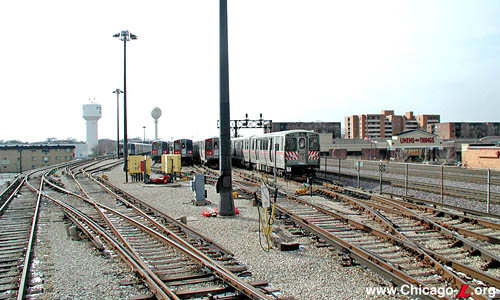
Harlem Yard, long but
narrow, is seen looking west on March 2, 2003. The
Harlem/Lake
station is behind the photographer, the Transportation
Building to the left, and a maintenance shop in the
distance, obscured by the parked rail cars. For a larger
view, click here.
(Photo by Graham Garfield)
|
Harlem Yard &
Shops
Marengo Avenue and Circle
Avenue, Village of Forest Park
Service
Notes:
|
Located:
|

|
Green Line:
Lake
|
Quick Facts:
Address: 1 S. Harlem
Avenue
Established: 1962
Shop Area: 37,570 square feet
Yard Area: 148,200 square feet
Rebuilt: n/a
Status: In Use
When the Lake Street Elevated was extended from Wisconsin station
in Oak Park to Forest
Park station at Circle and Marengo avenues on Chicago & North
Western Railroad property in the station's namesake suburb on May 20,
1910, only one track initially crossed Harlem Avenue to serve the
platform. Later, a second track and new buildings were added, but the
station was always lightly used and there was never a yard or shop
here, only two stub tracks. The Lake Street Elevated's storage yard
and car maintenance facility were at Hamlin
Avenue on the West Side of Chicago at a facility various called
Hamlin Shops, Avers Shops, Springfield Shops, and simply "the
carhouse" over the years.
When the CTA elevated the
suburban Lake Street "L" tracks in 1962, the Forest
Park station (along with all the rest of the grade-level
stations) was demolished. Instead of the rebuilding Forest Park and
the Wisconsin (now called Marion) stations, one new station was built
at Harlem as the line's
terminal. A new elevated yard and shop were to be built west of the
station. Harlem Yard now the site of the former Forest
Park station.
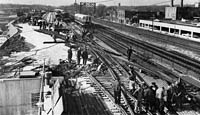
Car storage facilities at
Harlem were expanded to accommodate 86 cars during 1964.
Additional space was left at the west end of the yard for
more tracks and a shop. For a larger view, click
here.
(CTA Photo)
|
Construction of the new yard and maintenance facility at Harlem in
Forest Park was concurrent with the elevation project. The 'yard' at
Harlem was initially just a few tracks continuing west of the
Harlem/Lake terminal,
but expansion of Harlem Yard to the point where it was storing the
bulk of the cars assigned to Lake Street was pretty much complete by
December of 1963. However, construction of the shop and further
expansion of the yard at Harlem took a little longer.
The contract for the construction of a Transportation Building and
substation in the east end of the yard, at the corner of Harlem and
Circle adjacent to the Harlem
station, was awarded on September 5, 1963 to Taheny Brothers company. The two-story building was
85 feet by 53 feet and projected to cost $244,000. The substation and
Transportation Office, housing a breakroom, lockers, and restrooms
for operating personnel, offices, and clerks, were completed and
placed in service on December 6, 1964. The building was clad in tan
face brick and perhaps its most identifiable feature is a large
stainless steel CTA logo,
complete with "METROPOLITAN TRANSIT" banner,
on the building's east elevation. On the same date, the storage of
the major portion of cars assigned to the Lake Line was transferred
from Hamlin to Harlem following an expansion of the yard to
accommodate a total of 86 cars. This also ending the need to store
cars on the Lake Street center track between Rockwell and Pulaski.
But there was still no shop and insufficient room of the line's
entire roster. Additional space was left to the west of the yard for
additional tracks and a shop.
To equip the new substation, a contract for $339,178 was awarded to Allis-Chalmers Manufacturing company for a power rectifier and switchgear equipment. The new substation relieved overload conditions at the Lombard substation and provided additional capacity required by the establishment of the new Harlem Yard.
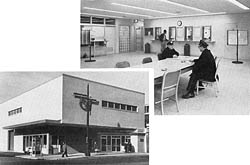
The two-story
station/substation/transportation office at Harlem/Lake was
constructed and opened in 1964. The exterior is looking
northwest from the corner of Harlem and South Boulevard; the
interior is the trainmen's room. For a larger view, click
here.
(Photos from the CTA 1964 Annual Report)
|
Although cars were now being stored at Harlem Yard, some cars were
still stored at Hamlin Yard. In 1965, four
additional tracks totaling 0.43 miles were laid in Harlem Yard. On
July 5, 1966, overnight lay-ups at Hamlin
Yard were eliminated. Henceforth, all car storage was at Harlem
Yard.
Work also began on a new inspection shop at the west end of the
yard. By March of 1966, there had been significant progress on the
shops and by the end of the year the facility was nearing completion.
The shop, with a floor area of 25,000 square feet, is a two-story
building with a structural steel frame clad in tan concrete face
brick.
Repair activities are concentrated on the second floor, which is
at the level of the elevated yard. The shop can accommodate as many
as 12 cars in five bays all of which face east: the northernmost
(Track A) is able to accommodate four cars inside the shop and the
remaining four (Tracks B through E) can accommodate two cars inside
the shop. Three hoists, each capable of lifting a 2-car train five
feet in the air off the tracks, provide easy access to the
undercarriage of the cars. One of them is also equipped with stands
that can support the train in an elevated position while one or all
of a car's trucks are lowered and removed. A two-car pit track is
provided for regular inspection and servicing of cars. A second pit
track on Track A is in an adjoining structure and includes a
high-pressure blow pit device for cleaning car undersides and a wheel
grinder for surfacing wheel treads without necessitating their
removal from cars.
Harlem Shops was specially designed to provide a centralized
facility for the maintenance and repair of air conditioning-equipped
rail cars. At the time, the
CTA had taken delivery of the
first series of cars air conditioning -- the Pullman-Standard
2000-series cars -- 140
out of a total of 180 of which were assigned to the Lake Line.
The Harlem Shop was completed and placed in service on June 19,
1967.
The infrastructure also included a water tower -- situated in the middle of the yard immediately east of the shop -- whose holding tank was almost perfectly spherical atop a tall support column. The water tower was initially used to supply water to fire suppression sprinklers and railcar-washing equipment. However, over the succeeding decades, the tower rusted and fell into disuse. Complaints about the rusted water tower from residents, businesses and officials on all sides of the yard -- the tracks and shop are located in Forest Park, but River Forest is located immediately north of the train embankment, and Oak Park is east of the yard on the other side of Harlem Avenue -- began as early as the early 2000s.1
Harlem Yard is a long, narrow yard, stretching roughly 0.3
miles from Harlem Avenue westward, parallel and adjacent to
the Chicago & North Western Railroad (now the Union Pacific). The
yard is nine tracks wide, with the Tracks 1 through 8 (from north to
south) being storage tracks. A ninth track (Track 9, natch) skirts
the south perimeter of the yard and leads to the shop at the west end
of the yard. The yard has a capacity of 130 cars (excluding shop
tracks and Track 9, the shop lead). A car washer is located on Track
8, just east of and in front of the shops.
Harlem Yard was removed from service in January 1994 when the
Green Line was closed for a
two-year rehabilitation. During its closure and isolation from the
system, the CTA stored some of
their historic cars were -- SSRT car 1 and Heritage Cars 1892-1992
(2007-08) -- as well as several 5-50
series cars. Following the completion of the Green
Line rehab, Harlem Yard was reenergized at 1800 hours on February
23, 1996. On February 27, 1996, the entire Lake branch from Tower #18
to Harlem Yard was returned to nonrevenue service at 1800 hours. The
Green Line resumed service on May
12, 1996.
Planned Renovation
By the early 2020s, CTA was working on a plan to rebuild the Harlem yard. As of early 2023, CTA still needed to secure funding for the project, however. It was expected to be largely funded through a combination of state and federal sources.2
CTA originally wanted to remove the disused water tower in the yard as part of the larger renovation project, but in a November 17, 2022 letter to Forest Park Mayor Rory Hoskins, Oak Park Village President Vicki Scaman, and River Forest Village President Cathy Adduci, CTA President Dorval Carter indicated that the water tower would be removed separately, potentially speeding up the project. Carter also said the CTA would be willing to work with all three villages to share the costs. However, while both CTA and the village of Forest Park floated the possibility of River Forest and Oak Park sharing some of the costs, Oak Park and River Forest rejected the idea of their taking part in cost-sharing.3
While River Forest supported the removal of the tower, officials stated they saw no reason to contribute financially, since the tower isn't on their land; however, they would support Forest Park in other ways, such as writing the letter of support in grant applications. Oak Park felt they should not have to contribute financially for similar reasons. In December 2022, Forest Park Village Administrator Moses Amidei noted that money from the Brown Street Station Tax Increment Financing District may be used for this purpose if the Illinois General Assembly extends the TIF, which was scheduled to expire at the end of 2023.4
In March 2024, Forest Park Village Administrator Rachell Entler stated that CTA planned to start the project to remove the water tower in Harlem Yard in March or April, and anticipate completing the project in late May or early June 2024. The contract for the removal was awarded to Granite Construction, who was issued a notice-to-proceed for the work on January 25, 2024. Preparatory work began in March or April for staging in the north parking lot and the main parking lot, as well as some preliminary utility work at track level within the yard vicinity. The removal work required CTA to close the yard for 16 days for heavy construction work, which was projected to start in early or mid-May through end of May or early June. Entler stated that the project cost to remove the water tower was estimated to be $175,000 but could be higher.5
Removal of the water tower did not actually occur until the weekend of November 16-17, 2024. First the bulb-shaped storage tank was removed from the top of the tower and lowered to the ground using a crane; then, the support tower was disassembled. The CTA paid for the water tower's removal, as of the time of removal still estimated to cost $175,000.6
The CTA still plans to redo the rest of the Harlem Yard in the future.7

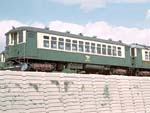
|
ctaS-355b.jpg
(85k)
When converted to work car service in December 1965, car
4315 was equipped with a snow plow to help clear the track
in winter. Given the service car number S-355, it is seen in
Harlem Yard in March, 1966. The
plow blade itself is steel edged with two-ply rubber car
flooring backed with canvas and fastened with carriage
bolts, which makes the edge stiff enough to clean down to
the running rails but safe to run along the third rail.
(Photo by Jerry Applemen)
|
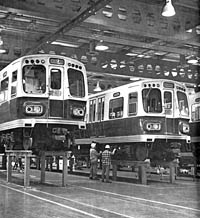
|
harlem02.jpg
(164k)
The interior of Harlem Shops is seen in 1967 with several
2000-series cars
up on hoists. The shop was especially designed to maintain
these High Performance cars, the first in a modern
CTA fleet and the
first to be equipped with air conditioning.
(CTA Photo, from 1967 CTA Annual
Report)
|
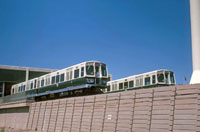 |
cta2000s10.jpg (148k)
Two 2000-series units, resplendent in their mint green and alpine white livery, sit in Harlem Yard awaiting their next trip in 1971. When these cars arrived in the mid-1960s, their aesthetic embodied the idea of what futuristic design looked like. (Photo by Lou Gerard) |
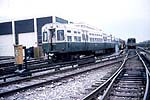
|
cta6778.jpg
(70k)
Car 6778 is at Harlem Yard in work service on April 15,
1986. Although the car is assigned to the North-South Route,
those cars doubled as work cars when extra work motors were
needed. A 2600-series
train can been seen in the background, on the right; the
Harlem Shop can be seen on the left. (Photo
by Peter Vesic)
|
|

|

|
Notes:
1. Studenkov, Igor. "Village neighbors won’t help pay for CTA water tower removal." Forest Park Review, January 3, 2023.
2. Ibid.
3. Ibid.
4. Ibid.
5. Lifka, Robert J. "CTA to remove Forest Park eyesore." Forest Park Review, March 19, 2024.
6. Mordacq, Jessica. "Rusty water tower torn down." Forest Park Review, November 18, 2024.
7. Ibid.









